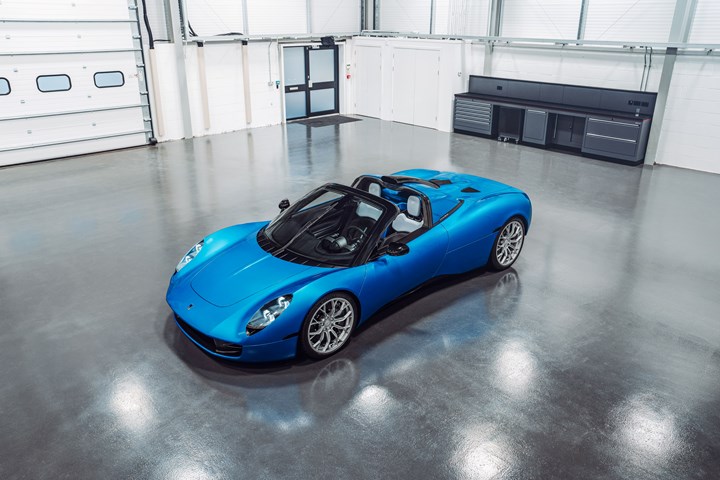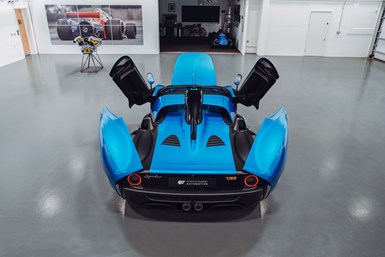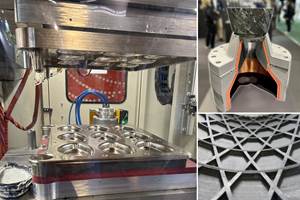The T.33 Spider: Another carbon fiber masterpiece from Gordon Murray
The legendary performance designer-engineer believes in purity of execution, and the T.33 Spider shows that the approach still drives him.

The composite-intensive, V12-powered Gordon Murray Automotive T.33 Spider. One hundred will be hand-built. Photo Credit, all images:
Gordon Murray, who has been involved in the design and engineering of some of the highest-performance cars in the world for the track and the motorway (he was, after all, awarded a CBE by Elizabeth II, so “road” or “expressway” just doesn’t work), operates with seven principles:
- Premium brand: hand-built British cars that are characterized by innovation and quality
- Beautiful and purposeful: Timeless balanced design; every part has a purpose
- Engineering art: Each component is both functional and a work of art
- Driving perfection: Assuring the experience behind the wheel is as good as it can be from the gauges to the throttle response
- Lightweight: Designing with minimal mass in mind helps deliver superior dynamics
- Exclusivity: Only 100 of any model or variant will be built
- Customer journey: The purchaser of any Gordon Murray Automotive vehicle will have complete involvement in the experience

The two removable roof panels are stored in the front 115-liter compartment (a.k.a., “frunk”), then there are two additional 90-liter storage compartments on either side of the T.33, under the rear composite fenders.
Earlier versions of those seven principles included
- Sustainable mobility
- Disruptive technologies
- Low energy solutions
Which undoubtedly had to give way, in part, when the subject is a vehicle that costs $2.35-million or more.*
A car like the just-revealed T.33 Spider. Which ticks the first seven boxes. It will be hand-built at the new Murray Highams Park facility in Windlesham, U.K., later this year so that each vehicle will be hand-tailored to customer requirements.
The vehicle has a dry weight (i.e., no fluids are in the vehicle) of 1,108 kilograms (2,437.6 pounds), so it is comparatively light.
The Structure
Like the T.33 coupe, the Spider has a carbon fiber composite monocoque construction. Carbon fiber composite panels are adhesively bonded to extruded aluminum tubing, with the tubing fitted to precision die-cast aluminum nodes.
Composites are also used in the interior: the leather wrapped steering wheel is produced with carbon fiber, as are the seat structures. The attention to weight reduction results in a vehicle with a dry weight of 1,108 kilograms (2,437.6 pounds).
Unlike the T.33 the Spider has removal carbon fiber composite roof panels that can be fitted in the 115-liter front luggage compartment when not in use. (Yes, there is what is now referred to as a “frunk” because the 608-hp 3.9-liter Cosworth GMA.2 V12 engine is located behind the cabin. The powertrain, incidentally, is a semi-structural component, with the rear suspension attached directly to the aluminum transmission case (the transmission is a six-speed manual).)
Although the T.33 Spider resembles the T.33 coupe, all surfaces behind the A-pillars are different on the two cars.
One of the issues of a spider (or a more ordinary convertible) is torsional rigidity. Once the roof panels are removed and the backlight lowered, the torsional rigidity could be reduced — but Gordon Murray said that the monocoque structure that is used provides exceptional stiffness in the rocker sections on either side of the vehicle, therefore removing any compromises.
In addition to which, spiders tend to be heavier — by even a couple hundred pounds — than their coupe variants mainly because of the need to provide additional components for enhancing stiffness. The T.33 Spider is just 18 kilograms (39.6 pounds) heavier than the coupe.
Which certainly ticks the “Lightweight” box.
* Supercars aren’t particularly examples of sustainability; the extensive use of carbon fiber construction for consumer cars is somewhat disruptive, but as Murray’s car company has been around since 2017, it isn’t particularly novel; and although mass reduction is a focus, one wouldn’t call a car powered by a V12 “low energy.”
Related Content
Welding is not bonding
Discussion of the issues in our understanding of thermoplastic composite welded structures and certification of the latest materials and welding technologies for future airframes.
Read MoreJEC World 2024 highlights: Thermoplastic composites, CMC and novel processes
CW senior technical editor Ginger Gardiner discusses some of the developments and demonstrators shown at the industry’s largest composites exhibition and conference.
Read MoreBladder-assisted compression molding derivative produces complex, autoclave-quality automotive parts
HP Composites’ AirPower technology enables high-rate CFRP roof production with 50% energy savings for the Maserati MC20.
Read MoreRevisiting the OceanGate Titan disaster
A year has passed since the tragic loss of the Titan submersible that claimed the lives of five people. What lessons have been learned from the disaster?
Read MoreRead Next
Cutting 100 pounds, certification time for the X-59 nose cone
Swift Engineering used HyperX software to remove 100 pounds from 38-foot graphite/epoxy cored nose cone for X-59 supersonic aircraft.
Read MoreCeramic matrix composites: Faster, cheaper, higher temperature
New players proliferate, increasing CMC materials and manufacturing capacity, novel processes and automation to meet demand for higher part volumes and performance.
Read MoreScaling up, optimizing the flax fiber composite camper
Greenlander’s Sherpa RV cab, which is largely constructed from flax fiber/bio-epoxy sandwich panels, nears commercial production readiness and next-generation scale-up.
Read More.jpg;width=70;height=70;mode=crop)












